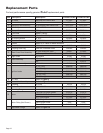
6104 BCF35 R11 Page 19
Start the Burner
Set Appliance Limit Controls
Set the appliance limit controls in accordance with
the appliance manufacturer’s recommendations.
Move the low-fi re hold switch (not shown) to the low
fi re hold position. This will hold the burner in low fi re
during initial start-up.
Prepare the Fuel Unit for Air Venting
To vent air from one-pipe oil systems, attach a clear
hose to the pump bleed port (item p in Figures 9 &
10) on the fuel unit. Provide a container to catch the
oil. Loosen the pump bleed port.
Vent the air as described in the ‘Start the Burner’
Section.
○
○
1.
2.
Start Burner and Vent Air from Oil Line
Move the low-fi re hold switch to the low fi re hold
position (to hold burner in low fi re when started).
Verify that the air adjusting cam (Figure 17B, item
d) has been set to the initial low-fi re air setting as
described in the ‘Initial Air Settings’ Section.
Open the oil shutoff valves in the oil supply line to
the burner.
Set the thermostat (or operating control) to call for
heat.
Close the line switch to the burner. The burner
motor should start immediately.
1.
2.
3.
4.
5.
Section: Prepare the Burner for Start-up
Professional Service
Required
Incorrect installation, adjustment, and
use of this burner could result in severe
personal injury, death, or substantial
property damage from fi re, carbon
monoxide poisoning, soot or explosion.
Please read and understand the manual supplied with
this equipment. This equipment must be installed,
adjusted and put into operation only by a qualifi ed
individual or service agency that is:
Licensed or certifi ed to install and provide technical
service to oil heating systems.
Experienced with all applicable codes, standards
and ordinances.
Responsible for the correct installation and
commission of this equipment.
Skilled in the adjustment of oil burners using
combustion test instruments.
The installation must strictly comply with all applicable
codes, authorities having jurisdiction and the latest
revision of the National Fire Protection Association
Standard for the installation of Oil-burning Equipment,
NFPA 31 (or CSA B139 and B140 in Canada).
Regulation by these authorities take precedence over
the general instructions provided in this installation
manual.
Do not proceed unless all prior steps in this manual
have been completed.
y
y
y
y
Explosion and Fire Hazard
Failure to follow these instructions could lead
to equipment malfunction and result in heavy
smoke emission, soot-up, hot gas puff-back,
fi re and asphyxiation hazards.
Do not attempt to start the burner when excess oil
has accumulated in the appliance, the appliance is
full of vapor, or when the combustion chamber is
very hot.
Do not attempt to re-establish fl ame with the burner
running if the fl ame becomes extinguished during
start-up, venting, or adjustment.
Vapor-Filled Appliance: Allow the unit to cool off
and all vapors to dissipate before attempting another
start.
Oil-Flooded Appliance: Shut off the electrical
power and the oil supply to the burner and then clear
all accumulated oil before continuing.
If the condition still appears unsafe, contact the Fire
Department. Carefully follow their directions.
Keep a fi re extinguisher nearby and ready for use.
y
y
y
y
y
y
Hot Gas Puff-back and
Heavy Smoke Hazard
Failure to bleed the pump properly could result in
unstable combustion, hot gas puff-back and heavy
smoke.
Do not allow oil to intermittently spray into a hot
combustion chamber while bleeding.
Install a gauge in the nozzle discharge port tubing or
fully open the pump bleed valve to prevent oil spray
from accumulating in the combustion chamber when
venting air from the fuel pump.
Ensure that all bubbles and froth are purged from
the oil supply system before tightening the pump air
bleed valve.
y
y
y


















